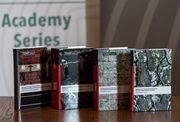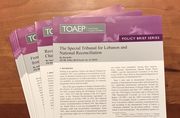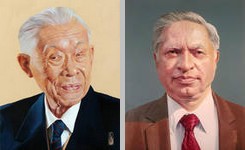Table of contents:
5. The perpetrator inflicted severe physical or mental pain or suffering upon one or more persons.
5.1. Infliction of physical or mental pain or suffering
5.1.1. Evidence of infliction, by act or omission, of physical pain or suffering
5.1.2. Evidence of infliction, by act or omission, of mental pain or suffering
5.1.3. Evidence of infliction, by act or omission, of both physical and mental pain or suffering
Element:
5. The perpetrator inflicted severe physical or mental pain or suffering upon one or more persons.
5.1.I nfliction of physical or mental pain or suffering
5.1.1. Evidence of infliction, by act or omission, of physical pain or suffering
According to the Trial Chamber in Krstić
"Cruel and inhumane treatment has been defined in the jurisprudence of the Tribunal as "an intentional act or omission, that is an act which, judged objectively, is deliberate and not accidental, which causes serious mental or physical suffering or injury or constitutes a serious attack on human dignity" and includes such offences as torture."[1]
According to the Trial Chamber in Mucić et al. ("Čelebići")
"The foregoing facts demonstrate that Dragan Kuljanin was subjected to deliberate ill treatment on numerous occasions during his detention in the Mucić et al. Čelebići prison-camp. The Trial Chamber finds that the beatings described above caused Mr. Kuljanin serious suffering and physical injury. Accordingly, with respect to each separate act of ill-treatment found above, the Trial Chamber finds that the offences of wilfully causing great suffering or serious injury to body or health under Article 2, and cruel treatment under Article 3 of the Statute, have been proven beyond a reasonable doubt."[2]
According to the Trial Chamber in Ntagerura et al.,
"The Chamber has found that, on 11 April 1994, soldiers arrested at least seven refugees, including Witness LI, near Cyangugu Cathedral and took them to the Kararnbo military camp in Cyangugu, as alleged in paragraph 3.20 of the indictment. [...] The soldiers repeatedly kicked and beat the refugees, including with the buns of their rifles, from the time of their arrest and through their incarceration at the camp. [...] During their incarceration at the camp, soldiers beat the detainees again with wooden sticks and rifle butts while threatening to beat them to death." "[3]
5.1.2. Evidence of infliction, by act or omission, of mental pain or suffering
5.1.3. Evidence of infliction, by act or omission, of both physical and mental pain or suffering
According to the Trial Chamber in Mucić et al. ("Čelebići")
"Accordingly, the Trial Chamber finds that the detainees in the Čelebići prison-camp were exposed to conditions in which they lived in constant anguish and fear of being subjected to physical abuse. Through the frequent cruel and violent deeds committed in the prison-camp, aggravated by the random nature of these acts and the threats made by guards, the detainees were thus subjected to an immense psychological pressure which may accurately be characterised as 'an atmosphere of terror'."[4]
The Trial Chamber in Jokić stated:
"The Trial Chamber also finds that there is sufficient evidence to establish beyond reasonable doubt that the brutal separation of the men from the women and children throughout the Potočari area on 12 and 13 July amounts to cruel and inhumane treatment. The Trial Chamber finds that the refugees who experienced the pulling apart of their families - who were aggressively separated and taken away from their beloved ones without knowing if they would ever see them again - suffered serious mental harm. As one example of an extremely aggressive separation that also caused serious bodily harm, the Trial Chamber recalls the evidence that a young boy was grabbed by the throat and "more or less strangled" when a VRS soldier tried to pull him away from his family."[5]
5.1.4. The severity of the pain or suffering inflicted
The Kvočka et al. Trial Chamber held that:
"In assessing the degree of harm required for an offence to qualify as cruel treatment, consideration should be given to the object and purpose of Common Article 3, which attempts to delineate a minimum standard of treatment to be afforded to persons taking no active part in the hostilities."[6]
The Kvočka et al.Trial Chamber opined that:
"a precise threshold for determining what degree of suffering is sufficient to meet the definition of torture has not been delineated. In assessing the seriousness of any mistreatment, the Trial Chamber must first consider the objective severity of the harm inflicted. Subjective criteria, such as the physical or mental effect of the treatment upon the particular victim and, in some cases, factors such as the victim's age, sex, or state of health will also be relevant in assessing the gravity of the harm"[7]
The Kvočka et al. Trial Chamber also precised:
"Damage to physical or mental health will be taken into account in assessing the gravity of the harm inflicted. The Trial Chamber notes that abuse amounting to torture need not necessarily involve physical injury, as mental harm is a prevalent form of inflicting torture. For instance, the mental suffering caused to an individual who is forced to watch severe mistreatment inflicted on a relative would rise to the level of gravity required under the crime of torture. Similarly, the Furundžija Trial Chamber found that being forced to watch serious sexual attacks inflicted on a female acquaintance was torture for the forced observer. The presence of onlookers, particularly family members, also inflicts severe mental harm amounting to torture on the person being raped."[8]
The Chamber also stated:
"Finally, it should also be noted that the Special Rapporteur on Torture, in his 1986 report, provided a detailed, although not exhaustive, catalogue of those acts which involve the infliction of suffering severe enough to constitute the offence of torture, including: beating; extraction of nails, teeth, etc.; burns; electric shocks; suspension; suffocation; exposure to excessive light or noise; sexual aggression; administration of drugs in detention or psychiatric institutions; prolonged denial of rest or sleep; prolonged denial of food; prolonged denial of sufficient hygiene; prolonged denial of medical assistance; total isolation and sensory deprivation; being kept in constant uncertainty in terms of space and time; threats to torture or kill relatives; total abandonment; and simulated executions."[9]
The Chamber added:
"it is difficult to articulate with any degree of precision the threshold level of suffering at which other forms of mistreatment become torture. However, the existence of such a grey area should not be seen as an invitation to create an exhaustive list of acts constituting torture, in order to neatly categorise the prohibition. As stated by Rodley, "... a juridical definition cannot depend upon a catalogue of horrific practices; for it to do so would simply provide a challenge to the ingenuity of the torturers, not a viable legal prohibition."[10]
The Trial Chamber in the Naletilić and Martinović ("Tuta and Štela") Case referred to the Kvočka Trial Judgment and stated that:
"the degree of physical or mental suffering that is required for inhumane treatment and cruel treatment is lower than the degree required for torture, though at the same level as the degree required to prove a charge of "wilfully causing great suffering or serious injury to body or health"[11]
Similarly, the Kunarac et al. Appeals Chamber found:
"Torture is constituted by an act or an omission giving rise to "severe pain or suffering, whether physical or mental", but there are no more specific requirements which allow an exhaustive classification and enumeration of acts which may constitute torture. Existing case-law has not determined the absolute degree of pain required for an act to amount to torture." "[12]
The Trial Chamber in Mrkšić et al. held that:
"Assessment of whether the acts charged as torture inflict severe pain or suffering will be made in light of all the circumstances of the case. These include the nature and context of the infliction of pain, the premeditation and institutionalization of the ill-treatment, the physical condition of the victim, the manner and the method used and the position of inferiority of the victim, the physical or mental effect of the treatment on the victim, the victim's age, sex, and state of health, and whether the mistreatment occurred over a prolonged period of time. There is no requirement that the act or omission has caused a permanent injury, or a physical injury as such, as mental harm is recognised as a prevalent form of torture. Further, it is now settled in the jurisprudence of the Tribunal that the perpetrator need not have acted in an official capacity."[13]
In Martić, the Trial Chamber stated that:
"The pain and suffering inflicted during acts of torture is more severe than the pain and suffering inflicted during other forms of mistreatment and cruel treatment. The Trial Chamber will assess on a case-by-case basis whether the acts or omissions charged as torture, inflicted severe physical or mental pain or suffering on the part of the victim.143 In its assessment of the severity of the pain or suffering inflicted, the Trial Chamber may take several factors into account, including the duration of the suffering inflicted, the nature of the crimes, the physical or mental condition of the victim, the effect of the acts on the victim, the victim's age, and the victim's position of inferiority to the perpetrator."[14]
"In the jurisprudence of the Tribunal several acts have been listed as rising to the level of seriousness necessary to constitute torture. These acts include beatings, administering electric shocks, forcing victims to watch executions of others, rape, forcing victims to bury the bodies of their neighbours and friends, and causing burn injuries."[15]
Footnotes:
[1] ICTY, Krstić Trial Judgment, 02 August 2001, para. 516.
[2] ICTY, Mucić et al. ("Čelebići") Trial Judgment, 16 November 1998, para. 1034.
[3] ICTR, Ntagerura et al. Trial Judgment 25 February 2004, para. 786.
[4] ICTY, Mucić et al. ("Čelebići") Trial Judgment, 16 November 1998, para. 1091.
[5] ICTY, Jokić Trial Judgment, 17 January 2005, para. 607.
[6] ICTY, Kvočka et al. Trial Judgment, 2 November 2001, para. 160.
[7] ICTY, Kvočka et al. Trial Judgment, 2 November 2001, para. 143.
[8] ICTY, Kvočka et al. Trial Judgment, 2 November 2001, para. 149.
[9] ICTY, Mucić et al. Trial Judgment, 16 November 1998, para. 467.
[10] ICTY, Mucić et al. Trial Judgment, 16 November 1998, para. 469.
[11] ICTY, Prosecutor v. Naletilić and Martinović ("Tuta and Štela"), "Judgment", IT-98-34-T,
[12] ICTY, Prosecutor v. Kunarac, Kovac and Vukovic, "Appeals Judgement", IT-96-23-T and IT-96-23/1-A, 12 June 2002, para. 149.
[13] ICTY, Mrkšić et al. Trial Judgment 27 September 2007 para. 514.
[14] ICTY, Martić Trail Judgment 12 June 2007 para. 75.
[15] ICTY, Martić Trail Judgment 12 June 2007 para. 76.







